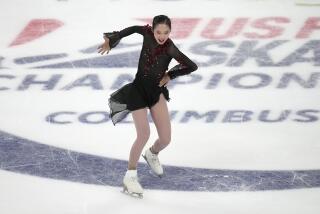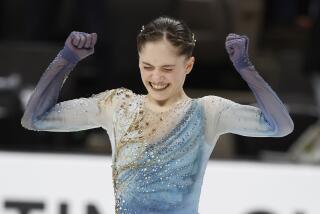It’s Kim Yuna and everyone else in women’s figure skating
- Share via
Reporting from Vancouver, Canada — One Olympic singles champion, Robin Cousins, says Kim Yuna has the “it factor.”
Another, Scott Hamilton, calls her a gift to the sport “from some other place.”
A rival’s coach, Frank Carroll, marvels at her speed.
One of the sport’s legendary skaters, Michelle Kwan, says Kim is “what the judges are looking for, when it comes to jump quality, spin quality and edges.”
All agree there is no way Kim will lose the Olympic gold medal in Thursday night’s long program if the 19-year-old South Korean skates the way she did in winning Tuesday’s short program.
“Who is going to challenge her?” Hamilton asks, the question rhetorical. “No one is going to beat her. She is going to have to beat herself.”
Kim has such a margin in overall quality -- and score -- over the rest of the field, including short program runner-up Mao Asada of Japan, that she likely can get away with one major mistake and still wind up with gold.
After all, Asada delivered a short program that was both historic and brilliant and wound up 4.72 points behind Kim.
The triple axel, with its forward takeoff and 3 1/2 revolutions in the air, is the most difficult jump women skaters attempt. In just a few seconds, Asada became both the first to do it and land it during an Olympic short program, and the first to do it as part of a jump combination, followed by a double toe loop, in any Olympic program.
“It was so impressive to see a triple axel/double toe and know that’s not good enough to win the short program,” said Kwan, two-time Olympic medalist and five-time world champion.
Impressive or depressing to everyone else?
“What might be going through Mao’s head is she has nothing to lose,” Kwan said.
Asada already planned to go for broke by trying two triple axels in the four-minute long program. Even that won’t be enough to beat a flawless Kim.
“Yuna is like Seabiscuit, a champion who found a way of breaking others’ will,” Hamilton said.
Kim has total command of all the elements necessary to get high scores in the mathematically complex and theoretically incorruptible judging system introduced as a reaction to the pairs judging scandal at the 2002 Winter Olympics.
There are 12 such elements in the women’s long program: seven jumping passes, three spins, a spiral sequence and a footwork sequence. Each gets a base value plus a grade of execution as a technical score. To that, the judges add component scores that evaluate five areas of what essentially is artistry.
The number of things a skater must cram into a program under the new judging system can lead to connect-the-dots skating that is often more masterful than beautiful.
To an audience, though, the most memorable thing about a performance is the overall impression it leaves, and music choice is critical.
No matter how well she skates Thursday, Asada will be overpowered by the dark, disturbing mood of Rachmaninoff’s C Sharp Minor Prelude. Kim can float along to the jazzy notes of Gershwin’s Concerto in F.
As in the short program, they will skate back-to-back in the final group of six, with Kim preceding Asada this time.
Canada’s Joannie Rochette, Japan’s Miki Ando and the two U.S. skaters, Rachael Flatt, 17, and Mirai Nagasu, 16, also are in the last group.
“Mirai came here basically as a nobody,” said Carroll, her coach. “To be in the last group is wonderful.”
Flatt, fifth in last year’s world championships, begins the long program 6.72 points from third place. Nagasu, in her first major senior-level competition, is 7.6 back.
Neither can win a medal without significant mistakes by Rochette, who had been inconsistent this season but found uncommon strength just to get on the ice, let alone to skate as well as she did, after her mother’s unexpected death Sunday.
Kim is trying to become the first South Korean to win any figure skating medal, let alone gold. In the short program, she had to deal with not only that but the sudden pressure of having Asada bring down the house immediately before Kim skated.
More to Read
Go beyond the scoreboard
Get the latest on L.A.'s teams in the daily Sports Report newsletter.
You may occasionally receive promotional content from the Los Angeles Times.






